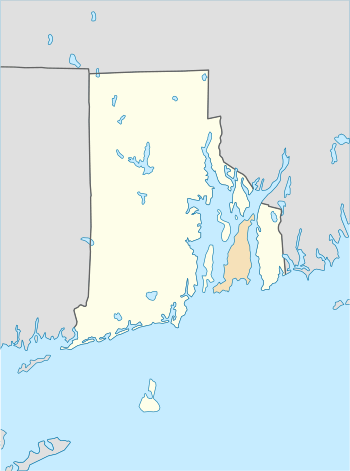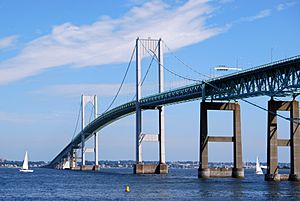Aquidneck Island facts for kids

Aquidneck Island highlighted in the state of Rhode Island
|
|
| Geography | |
|---|---|
| Location | Narragansett Bay |
| Coordinates | 41°33′20″N 71°15′53″W / 41.55556°N 71.26472°W |
| Area | 37.8 sq mi (98 km2) |
| Length | 15 mi (24 km) |
| Width | 5 mi (8 km) |
| Highest elevation | 260 ft (79 m) |
| Highest point | Slate Hill |
| Administration | |
|
United States
|
|
| State | Rhode Island |
| County | Newport County |
| Largest settlement | Newport (pop. 25,163) |
| Demographics | |
| Population | 60,109 |
| Pop. density | 613 /km2 (1,588 /sq mi) |
Aquidneck Island (pronounced uh-KWID-nek), officially known as Rhode Island, is a large island located in Narragansett Bay. This island is part of the state of Rhode Island. It covers about 37.8 square miles (97.9 square kilometers), making it the biggest island in the bay.
In 2020, about 60,109 people lived on Aquidneck Island. Interestingly, the entire state of Rhode Island is named after this island. Even though its official name is "Rhode Island," many people in the state and those who live there still call it Aquidneck Island.
Three towns are located on Aquidneck Island. From north to south, they are Portsmouth, Middletown, and Newport.
Contents
What Does "Aquidneck" Mean?
The name "Aquidneck" comes from the Narragansett language. The Narragansett people were Native Americans who lived in this area. Their word for the island was aquidnet.
Roger Williams, who was good at the Narragansett language, said he never found out what the word aquidnet actually meant.
How the Island Got Its Name
It's not completely clear how Aquidneck Island also became known as Rhode Island. The name "Rhode Island" was first used in 1637 by Roger Williams. In 1644, it was officially decided that the island would be called "the Ile of Rods or Rhod-Island."
One idea is that Adriaen Block, a Dutch explorer, saw the island in 1614. In 1625, he described it as "an island of reddish appearance." Old Dutch maps from 1659 show it as "Roode Eylant," which means Red Island. Historians think the Dutch might have named it because of the red leaves in autumn or the red clay on the shore.
In 1644, the towns on the island joined with other settlements to form the Colony of Rhode Island and Providence Plantations. This colony later became the State of Rhode Island. Today, the whole state is commonly called Rhode Island. The official name of Aquidneck Island is still "Rhode Island."
In 1930, the United States Board on Geographic Names used both names for the island on its maps. But by 1964, they decided that having two names was confusing. So, "Rhode Island" became the only official name for the island. People have tried to change the official name back to "Aquidneck Island," even in 2004, but these attempts have not succeeded. Still, many people in Rhode Island, including local newspapers, often use the name Aquidneck Island.
Island History
Colonists first settled on Aquidneck Island in 1638. They settled in the northern part, which the Narragansetts called "Pocasset." This name meant "where the stream widens."
The settlers asked Roger Williams to help them buy the island from the Narragansett leaders, Canonicus and Miantonomi. The settlers paid the Narragansetts with items like wampum (shell beads), hoes, and coats. Canonicus and Miantonomi signed a deed for the land.
However, Roger Williams wrote in a letter in 1638 that the island was not truly "sold." He said that the payment was more like a gift, even though they called it a "sale" for legal reasons. He explained that the Narragansetts would not have sold the island for any amount of money to strangers.
The first settlers founded Pocasset. But in the spring of 1639, William Coddington chose Newport for a new settlement. He liked Newport because it had an excellent harbor. Some of the original settlers followed him there.
During the American Revolution, the British army took control of Aquidneck Island from 1776 to 1779. The American army, led by Major General John Sullivan, tried to force the British out. This happened during the Battle of Rhode Island on August 29, 1778, but the Americans were not successful.
Schools and Learning
Aquidneck Island is home to several schools and learning centers.
- Salve Regina University is located here.
- The Newport campus of the Community College of Rhode Island is also on the island.
- The International Yacht Restoration School teaches students how to restore old boats.
- Naval Station Newport, a large naval base, is partly on Aquidneck Island. It also covers the nearby Coasters Harbor Island.
The island also has two well-known private boarding schools:
- St. George's School in Middletown.
- Portsmouth Abbey School in Portsmouth.
Besides these, there are many public and private schools for younger students. These schools are part of the school systems in Newport, Middletown, and Portsmouth.
Connecting Bridges
Aquidneck Island is connected to the mainland and other islands by three bridges:
- The Claiborne Pell Newport Bridge was built in 1969. It connects Aquidneck Island to Jamestown on Conanicut Island. From Conanicut Island, you can then reach the mainland.
- The Mount Hope Bridge was built in 1929. It connects the northern part of Aquidneck Island in Portsmouth to the mainland at Bristol.
- The Sakonnet River Bridge was built in 2012. This bridge in Portsmouth connects the northeastern side of the island to the mainland at Tiverton. It crosses the Sakonnet River, which is a narrow saltwater channel. This bridge replaced an older one with the same name from 1956.
Environmental Cleanup Efforts
Part of the west coast of Aquidneck Island is home to Naval Station Newport. This area was named a "Superfund" site in 1989. A Superfund site is a place where harmful substances have been found, and the government works to clean them up.
Water from the Navy's fuel tank areas used to drain into ditches and then into Narragansett Bay. The Navy has been working to clean up the property. They are removing pollution from things like petroleum, heavy metals (like lead and arsenic), and other industrial chemicals. They are also addressing certain types of chemicals found in the groundwater and surface water runoff. This groundwater is sometimes used for watering crops and lawns. The Navy continues its efforts to make the area safe and clean.
See also
 In Spanish: Isla Aquidneck para niños
In Spanish: Isla Aquidneck para niños


